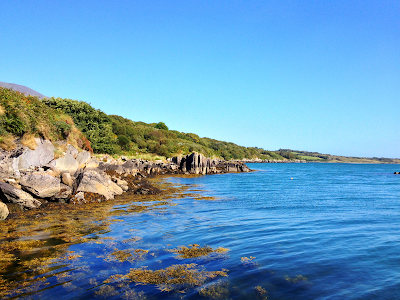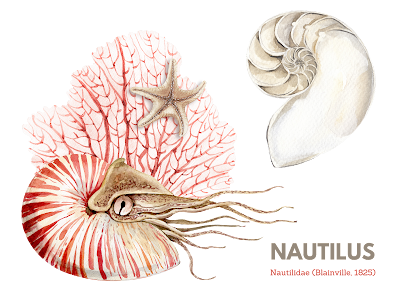Plant fossils are found coast-to-coast in Canada, from 45-million-year-old mosses in British Columbia to fossil forests on Axel Heiberg and Ellesmere islands in the Canadian Arctic.
The early angiosperms developed advantages over contemporary groups — rapid reproductive cycles — which made them highly efficient, adapting well to "weedy" growth. These modifications, including flowers for the attraction of insect pollinators, proved advantageous in many habitats.
Interaction between plant and pollinator has been a driving force behind the astounding diversification of both flowering plants and insects. Together, they tell one of the most interesting co-evolutionary stories on Earth, and one of vital importance to us. We must give thanks to our precious bees for their work pollinating about one-third of our diet and adding nutritious and delicious fruits and vegetables to our menu.
Some of the earliest known flowering plants are found in northeastern British Columbia coalfields. Late Cretaceous (about 101–66 million years ago) floras of the Dawson Creek area of British Columbia, and Milk River, Alberta, reveal increasing dominance by angiosperms.
During this interval of mass extinction, the Earth was struck by a massive meteorite. The fallout from this impact is preserved in boundary sediments in southern Saskatchewan as a pale clay, rich in rare earth elements such as iridium.
In the early Paleogene period (66–56 million years ago), we entered the age of mammals. Paralleling the rise of mammals is the rise of modern flora, which consists overwhelmingly of our glorious flowering plants. One of the most prolific fossil sites for Paleogene flowering plants, fruits and seeds is the Messel pit in Germany. In 2012, a research group found over 140 different plant species, 65 of which were previously unknown.
Early Paleogene fossils are found over much of Alberta — Red Deer River, Lake Wabamun coalfields and Robb to Coal Valley coalfields — and southern Saskatchewan — Eastend area to Estevan coalfield — to as far north as Ellesmere Island. These floras reveal a variety of flowering plants, including members of the sycamore, birch and walnut families, but the most abundant fossil plants are the katsuras and the dawn redwood, now native only to southeastern Asia.
In the mid-Paleogene period (56–34 million years ago) brief climatic warming coincided with the rapid diversification of flowering plants. Eocene fossils in British Columbia (Princeton, Kamloops and Smithers areas) reveal increasing numbers of modern plant families, with extinct species of birch, maple, beech, willow, chestnut, pine and fir.
 |
| Fossil Leaves, Princeton, British Columbia, Canada |
Exceptionally well-preserved fossil forests found on Axel Heiberg and Ellesmere islands in the Canadian Arctic illustrate clearly the contrast between modern Canadian vegetation and the floras of a much warmer past. These fossil forests, 40 to 60 million years old, consist of large stumps, many over 1 m in diameter, preserved where they grew, still rooted in ancient soil.
Thick mats of leaf litter that formed the forest floor reveal the types of plants inhabiting the forests.
Lush redwood and cypress swamps covered the lowlands, while the surrounding uplands were dominated by a mixed conifer and hardwood forest resembling that of modern eastern North America. Even accounting for continental drift, these forests grew well above the Arctic Circle, and bear witness to a time in Canada's past when a cold arctic climatic regime did not exist.
Around 45-50 million years ago, during the middle Eocene, a number of freshwater lakes appeared in an arc extending from Smithers in northern British Columbia, south through the modern Cariboo, to Kamloops, the Nicola Valley, Princeton and finally, Republic, Washington.
The lakes likely formed after a period of faulting created depressions in the ground, producing a number of basins or grabens into which water collected — imagine gorgeous smallish lakes similar to Cultus Lake near Chilliwack, British Columbia.
The groaning Earth, pressured by the collision of tectonic plates produced a series of erupting volcanoes around the Pacific Northwest. These spouting volcanoes blew fine-grained ash into the atmosphere and it rained down on the land.
 |
| Eocene Plant Fossils, McAbee, BC |
The ash washed into the lakes and because of its texture, and possibly because of low water oxygen levels on the bottoms that slowed decay beautifully preserved the dead remains of plant, invertebrate, and fish fossils — some in wonderful detail with fascinating and well-preserved flora.
Near the town of Princeton, British Columbia, we see the results of that fine ash in the many fossil exposures. The fossils you find here are Middle Eocene, Allenby Formation with a high degree of detail in their preservation. Here we find fossil maple, alder, fir, pine, dawn redwood and ginkgo material. The Allenby Formation of the Princeton Group is regarded as Middle Eocene based on palynology (Rouse and Srivastava, 1970), mammals (Russell, 1935; Gazin, 1953); freshwater fishes (Wilson, 1977, 1982) and potassium-argon dating (Hills and Baadsgaard, 1967).
Several species of fossilized insects can be found in the area and rare, occasional fossil flowers and small, perfectly preserved fish. More than 50 flowers have been reported (Basinger, 1976) from the Princeton chert locality that crops out on the east side of the Similkameen River about 8 km south of Princeton, British Columbia.
The first descriptions of fossil plants from British Columbia were published in 1870–1920 by J.W. Dawson, G.M. Dawson, and D.P. Penhallow. Permineralized plants were first described from the Princeton chert in the 1970s by C.N. Miller, J.F. Basinger, and others, followed by R.A. Stockey and her students. W.C. Wehr and K.R. Johnson revitalized the study of fossils at Republic with the discovery of a diverse assemblage in 1977.
In 1987, J.A. Wolfe and Wehr produced a United States Geological Survey monograph on Republic, and Wehr cofounded the Stonerose Interpretive Center as a venue for public collecting. Systematic studies of the Okanagan Highlands plants, as well as paleoecological and paleoclimate reconstructions from palynomorphs and leaf floras, continue to expand our understanding of this important Early Eocene assemblage.
One of the sister sites to McAbee, the Driftwood Canyon Provincial Park Fossil Beds, offers an honours system for their site. Visitors may handle and view fossils but are asked to not take them home. Both Driftwood Canyon and McAbee are part of that arc of Eocene lakebed sites that extend from Smithers in the north, down to the fossil site of Republic Washington, in the south. The grouping includes the fossil sites of Driftwood Canyon, Quilchena, Allenby, Tranquille, McAbee, Princeton and Republic. Each of these localities provides important clues to our ancient climate.
The fossils range in age from Early to Middle Eocene. McAbee had a more temperate climate, slightly cooler and wetter than other Eocene sites to the south at Princeton, British Columbia, Republic in north-central Washington, in the Swauk Formation near Skykomish and the Chuckanut Formation of northern Washington state. The McAbee fossil beds consist of 30 metres of fossiliferous shale in the Eocene Kamloops Group.
The fossils are preserved here as impressions and carbonaceous films. We see gymnosperm (16 species); a variety of conifers (14 species to my knowledge); two species of ginkgo, a large variety of angiosperm (67 species); a variety of insects and fish remains, the rare feather and a boatload of mashed deciduous material. Nuts and cupules are also found from the dicotyledonous Fagus and Ulmus and members of Betulaceae, including Betula and Alnus.
We see many species that look very similar to those growing in the Pacific Northwest today. You can find well-preserved specimens of cypress, dawn redwood, fir, spruce, pine, larch, hemlock, alder, birch, dogwood, beech, sassafras, cottonwood, maple, elm and grape. If we look at the pollen data, we see over a hundred highly probable species from the site. Though rare, McAbee has also produced spiders, birds (and lovely individual feathers) along with multiple specimens of the freshwater crayfish,
Aenigmastacus crandalli.
For insects, we see dragonflies, damselflies, cockroaches, termites, earwigs, aphids, leafhoppers, spittlebugs, lacewings, a variety of beetles, gnats, ants, hornets, stick insects, water striders, weevils, wasps and March flies. The insects are particularly well-preserved. Missing are the tropical Sabal (palm), seen at Princeton.
200 km to the south, fossil leaves and fish were first recognized at Republic, Washington, by miners in the early 1900s. We find the impressive Ensete (banana) and Zamiaceae (cycad) at Eocene sites in Republic and Chuckanut, Washington. Many early workers considered these floras to be of Oligocene or Miocene age. C.A. Arnold described Canadian occurrences of conifers and Azolla in the 1950s. Palynological studies in the 1960s by L.V. Hills, G.E.Rouse, and others and those of fossil fish by M.V.H. Wilson in the 1970–1980s provided the framework for paleobotanical research at several key localities.
With the succession of ice ages that swept down across North America in the Pleistocene, there were four intervening warm periods. These warmer periods help many species, including the genus Oenothera, enjoy four separate waves of colonization — each hybridizing with the survivors of previous waves. This formed the present-day subsection Euoenothera. The group is genetically and morphologically diverse and contains some of the most interesting of the angiosperms.
Today, there are about 145 species of herbaceous flowering plants in the genus Oenothera, all native to the Americas. It is the type genus of the family Onagraceae. We know them by many names — evening primrose, suncups, and sundrops — but they are not closely related to the true primroses (genus Primula).
Oenothera flowers are pollinated by insects, such as moths and bees. One of the most interesting things I have learned (thank you, Jim Barkley) is a clever little evolutionary trait exhibited by the beach evening primrose,
Oenothera drummondil. These lovelies can actively sense and respond to the buzzing of bees. Marine Veits et al. were able to show that this species has evolved to respond to the sound of bees by producing nectar with a higher sugar concentration, certainly yummy by bee standards — therein attracting more pollinators and increasing the plant species reproductive success.
David R. Greenwood, Kathleen B. Pigg, James F. Basinger, and Melanie L. DeVore: A review of paleobotanical studies of the Early Eocene Okanagan (Okanogan) Highlands floras of British Columbia, Canada, and Washington, USA.
Sauquet H, von Balthazar M, Magallón S, et al. The ancestral flower of angiosperms and its early diversification. Nat Commun. 2017;8:16047. Published 2017 Aug 1. doi:10.1038/ncomms16047
Marine Veits Itzhak Khait Uri Obolski, et al. Flowers respond to pollinator sound within minutes by increasing nectar sugar concentration. https://doi.org/10.1111/ele.13331


































